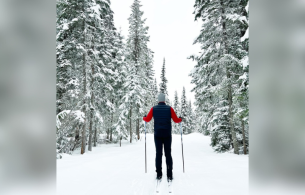Unfortunately, thanks to climate change, it seems we are gaining a fifth season – “wildfire season” – which doesn’t seem to recognize the traditional boundaries of our four seasons. Wildfire season usually happens during the summer but could start as early as spring and last well into fall, and we’ve been experiencing some periods of pretty terrible air quality as a result. This can lead to the following advice being broadcast widely: “stay inside and postpone outdoor activity due to poor air quality.”
Northerners are known for our love of the outdoors, and specifically making the most of our short summers by cramming as many fun and healthy outdoor activities into our schedule as we can manage. The physical and mental health benefits of getting active outdoors are generally greater than those associated with indoor activity. So, how do we make the most of our seasons while protecting our health?
The good (AKA why/when/how to stay active):
- For those who are healthy, the benefits of getting active outdoors generally outweigh the risks of exposure to lower air quality due to wildfires.
- Regular physical activity actually has a protective effect during periods of lower air quality.
Of course, it’s always best to minimize our exposure when air quality is lacking. We can limit our individual exposure by time, space, and activity:
- Choose your time wisely: Get outdoors during the parts of the day when air quality is better (i.e. usually mornings and evenings, but depends on the weather, winds, etc.). Watch the weather forecast and pick the times that will be best.
- Location, location, location: If possible, get active near green or blue spaces (e.g. parks, trails, by rivers and lakes, etc.) as the air quality is always better in these locations versus in town, on roadways, etc.
- Move indoors: Move your activity to a clean air indoor space (more on this in The Bad and the Ugly).
- Lower the intensity: Physical activity is not an “all out or nothing” event. Any movement is good movement, so rather than cancelling altogether when conditions aren’t perfect, simply adjust. Pick an activity that doesn’t make you huff and puff, but still raises your heart rate (e.g. a walk, yoga, or leisurely wheel rather than a jog or road race).
- Mask up: Remember masks? If you’re like me, you probably have a stockpile of them at home. You can consider wearing a medical grade mask before, during, and/or after your activity to breathe in fewer particles. Masks must fit well and be replaced when saturated in order to work properly.
*Important: No matter what you do or how healthy you are, always listen to your body and monitor for symptoms such as irritated throat, cough, etc., and adjust as needed.
The bad:
- We can’t assume the air quality indoors is significantly better than the air quality outdoors. Unless windows are closed (temperature permitting) and the indoor air is clean (i.e. with air conditioners, filters, and/or air purifiers), it might be just as bad indoors as out.
- The risk of exposure goes up along with activity intensity. In other words, the faster and deeper you’re breathing, the more exposed you are. This is why we recommend reducing intensity or choosing a different time to head outdoors if possible.
- There will likely be some days this summer where the air quality is poor enough that even the healthiest folks should limit or avoid outdoor activity altogether. Take advantage of the decent days and times, but know your limits.
The ugly (AKA – “It’s complicated”):
- The general advice to stay inside and postpone outdoor activity errs on the side of caution and is appropriate for people who are more at risk or vulnerable to the effects of wildfire smoke, including children, older adults, those with chronic disease such as COPD, asthma, etc.
- Only a few Northern communities have an Air Quality Health Index rating, so it can be difficult to determine what times of day and locations will be best for getting outdoors.
- It’s not as easy as “just move inside.” While there are a few public spaces with cleaner air available in some communities (e.g. malls, indoor walking tracks, gyms and recreation centres, public libraries, etc.), it’s not safe or fair to assume that all members of our community have access to these places. More must be done to provide equitable access to clean air spaces (e.g. free spaces and/or discounted or free access during periods of lower air quality, etc.).
For more resources on wildfire smoke, visit the Northern Health Wildfire Smoke page














Comments